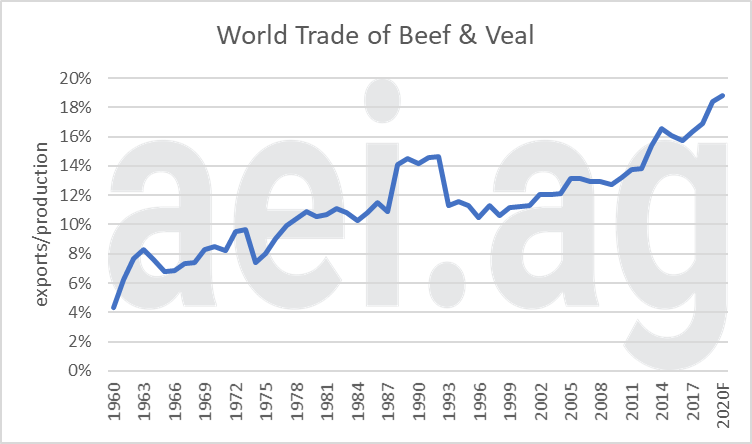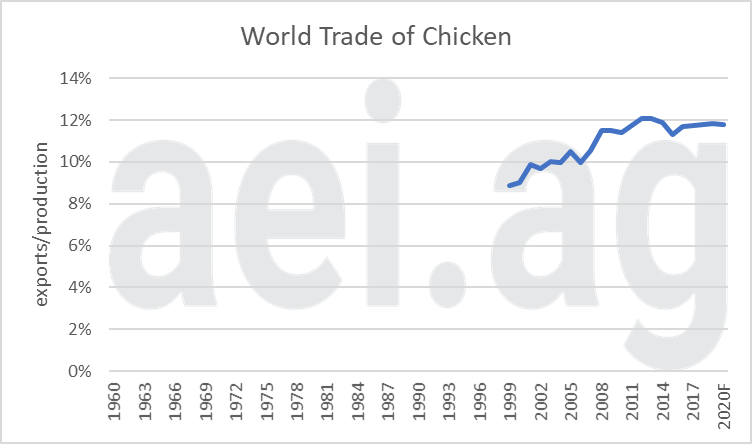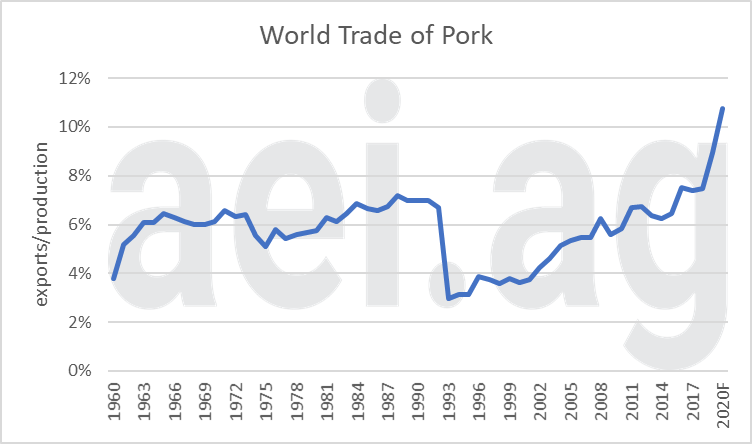Is the World More Reliant on Meat Trade?
Last week’s post looked at the expanding impact of trade in U.S. meat, especially beef and pork. As a follow-up, this week’s post considers the trends in world trade of beef, chicken, and pork. Is the world more reliant on meat trade?
Beef
Figure 1 shows the annual world exports of beef & veal as a share of production. This measure is helpful as it captures the share of global production reliant on trade.
A quick glance shows the trend has been upward of the past 60 years. During the 1960s, less than 10% of total global beef & veal production was tied to exports. Most recently, however, nearly 20% of production is reliant on exports.
Not shown in Figure 1 – but worth mentioning- is the absolute change in beef & veal exports. Between 2000 to 2020, beef & veal exports have nearly doubled (5.9 million MT CWE to 11.6 million MT CWE). Over the past two decades, pounds of beef & veal exports have increased at a 3.4% average annualized rate of growth.

Figure 1. World Trade of Beef & Veal, Exports/Production. 1960- 2020F. Data Source: USDA’s FAS PS&D Database.
Chicken
Figure 2 shows the trend for global chicken exports. Like last week, reported USDA begins in 1999. Overall, the trend here has also been higher. Global chicken exports have increased from less than 10% of production prior to 2001, to 12% in recent years.
Since 2000, chicken exports – measured in metric tons of product (not shown in Figure 2)- have increased at a 4.7% average annualized rate.

Figure 2. World Trade of Chicken, Exports/Production. 1960- 2020F. Data Source: USDA’s FAS PS&D Database.
Pork
Figure 3 shows the world trade of pork. Like the other meats, the pork trend is also upward over the last 6 decades. After a significant drop in exports in the early 1990s, the upward trend has been striking. In 2019, total pork exports accounted for 9% of production. For 2020, exports are forecasted at nearly 11% of production.
Not shown in figure 3 is the absolute change in pork exports. Since 2000, the total tons of pork exports have more than tripled; from 3.1 million metric tons (CWE) to a forecasted 10.4 million metric tons (CWE). The increase in tons of pork exports over the last 2 decades has been an average, annualized rate of 6.2%, much larger than beef and chicken.

Figure 3. World Trade of Pork, Exports/Production. 1960- 2020F. Data Source: USDA’s FAS PS&D Database.
Wrapping it Up
With all eyes on trade and African Swine Fever (ASF), it’s worth noting the trend towards more global trade – for both meat and grain – has been underway for decades. That said, the Phase 1 trade agreement and spread of ASF could push meat exports even higher in 2020, and beyond.
While exports – when measured as a share of production – have been increasing across the three considered, it’s worth keeping in mind the underlying data have differences. First, the magnitudes of trades significantly vary. For beef & veal, exports account for nearly 20% of global production. For chicken and pork, exports account for a smaller share of production (less than 12%).
Second, the rate of growth in tons of product exported has also varied. Physical exports of pork have increased at a much faster rate than compared to beef and chicken.
Click here to subscribe to AEI’s Weekly Insights email and receive our free, in-depth articles in your inbox every Monday morning.
You can also click here to visit the archive of articles – hundreds of them – and to browse by topic. We hope you will continue the conversation with us on Twitter and Facebook.
Source: David Widmar, Agricultural Economic Insights
